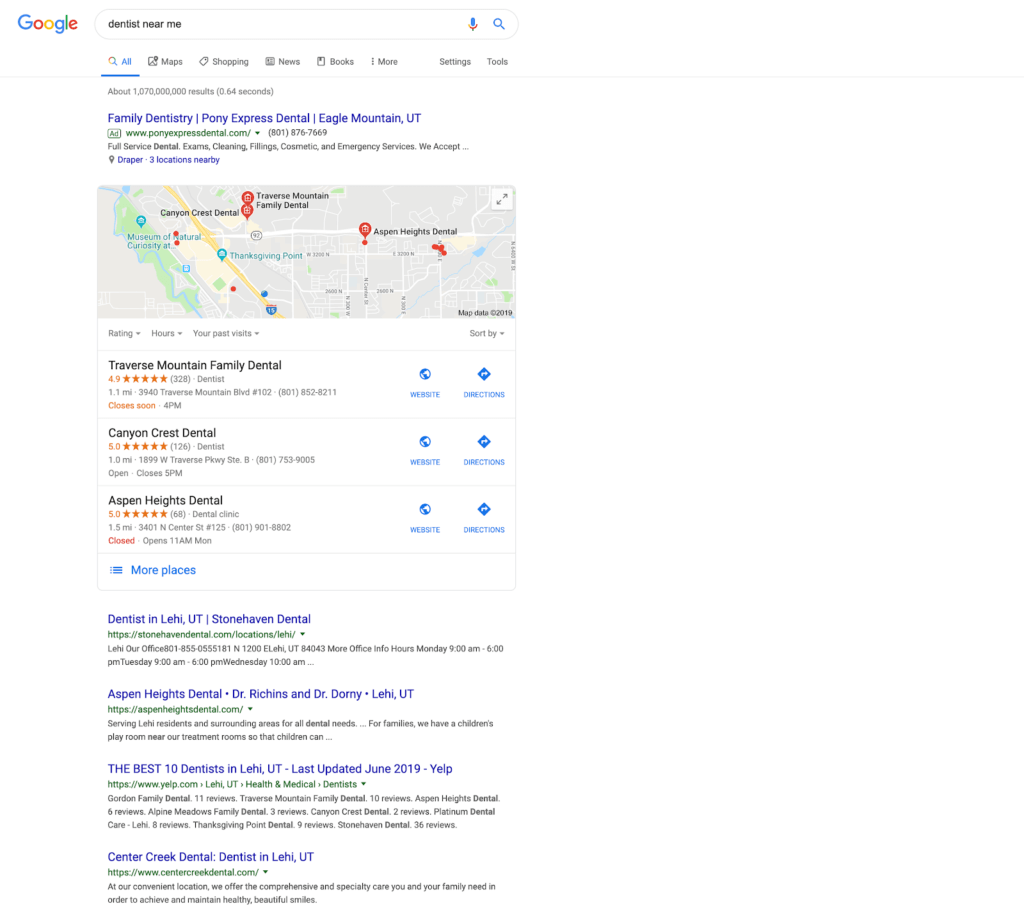What is Local SEO? Step-by-Step Guide for 2024
What is Local SEO?
Local SEO is search engine optimization for local marketing. It’s the practice of optimizing your website to be crawled and indexed by search engine bots called crawlers in order to be found by nearby customers in search engine results page (also known as SERP).

Local SEO is unique in that it takes into account the searchers proximity to their desired result. For example, searching for best dentist near me will produce a list of highly-rated dentist offices within a few miles of your approximate location.
Google prioritizes local businesses in the results for local searches like these in a search result feature called Map Pack.

Getting to the top of Google may seem impossible for local business owners, but if your business has a physical location, you already have an advantage over purely online businesses.
To optimize your business listing for local SEO, first, you need to understand the three main ranking factors that Google uses for local search. Once you understand how rankings are determined we’ll walk through each step of showing up in local search.
How Google determines local search rankings?
The details of how Google calculates local search ranking are kept fairly quiet, but according to Google there are three major factors businesses should focus on when optimizing for local search.
Relevance: The goal of Google’s local search algorithm is to connect searchers with answers. So when they search for a nearby tire shop, they get the best recommendations. Making sure your Google Business Profile is accurate and up-to-date guarantees that potential customers looking for a business like yours will find you instead of a competitor who’s not open, for example.
Distance: Proximity of the searcher to your business is another major factor Google takes into account when determining local search ranking. Because of this, it is important to include your address and other relevant contact information in your Google Business Profile and in other directories across the internet.
Prominence: Finally, Google takes into account the prominence of your business. What they mean by prominence is how well is this business known. Prominence also factors in things like directory listings, and online reviews. According to Google both a business’ overall star rating and the number of reviews are used to determine local search rankings.
How to Do Local SEO effectively
SEO is too hard and completely unpredictable. At least that seems to be the prevailing theory for a lot of business owners. But it doesn’t have to be hard or complicated, especially for a local business. Contrary to popular belief, you don’t need to understand meta tags, link juice, or latent semantic index keywords in order to do local SEO well.
You don’t even need an SEO strategy to improve your local SEO and start getting found in more search results. You just need to make a few updates to your Google Business Profile. Below is a local SEO checklist to help you follow each piece step-by-step.
Local SEO Checklist
- Adding complete information to your Google Business Profile
- Verifying your locations
- Keeping your hours accurate and up-to-date
- Managing and responding to reviews
- Adding high-quality photos
1. Adding Complete Info to Your Google Business Profile
According to Google, “businesses with complete and accurate information are easier to match with the right searches.” If your Google Business Profile is incomplete, or worse, non-existent, then it’s harder for search engines to match your business with local customers on Google.
Creating Google Business Profile is just the first step. Once your listing is created, you’ll need to add as much information as possible. Don’t worry about adding specific keywords, just make your profile as complete as possible.
Potential customers want to know who you are, where you are, and when they can visit you. So before you get started, make sure you have all of your basic business information at your fingertips.
- Who You Are
- Name
- Website
- Business Description
- Category
- Attributes
- Opening Date
- Photos
- Where You Are
- Address
- Service Area
- When They Can Visit You
- Hours of Operation
- Holiday Hours
Consistency Counts
It’s important that your business name, address, and phone number (commonly referred to as NAP) are consistent across the web so customers, and crawlers, can identify your business.
Believe it or not, inconsistent NAP information is one of the leading causes of a poor local search ranking. So if your address has the word lane in it, the word should either always be abbreviated or always be spelled out.
- Mike’s HVAC
- 123 Southview Lane
- Troy, OH
- 45373
- Mike’s HVAC
- 123 Southview Ln.
- Troy, OH
- 45373
2. Verifying Your Locations
Before your Google Business Profile appears in Search and Maps it must be verified. Verifying your listing is a simple process and Google offers a few different ways to do it.
| On Your Computer | On Your Smartphone |
|
|
You can also use Google Maps to add or claim your business on both desktop and mobile.
3. Keeping Hours Accurate and Up-to-Date
It’s also important to include accurate, up-to-date hours of operation in your listing. Make sure that you include special holiday hours, to avoid frustrating customers who make their way to your business only to find out you are closed.
4. Managing and Responding to Reviews
Businesses that want to improve their local SEO ranking should collect and manage online reviews. Moz estimates that your Google Business Profile and Google Reviews account for 40% of local pack ranking factors.
Online reviews will not only bolster your local SEO but will help build trust with customers and potential customers. When your customers are happy, they help influence others. If you make it easy for customers to leave a review, you’ll get more reviews which will directly impact your local SEO.
Sometimes it can be difficult for businesses to collect online reviews organically, so they need to take a more proactive approach. Below are some tips that will increase the odds of getting a customer to leave a review.
How to Rapidly Increase Google Reviews & Ratings
1. Determine the right timing of the invitation: When a customer receives an online review invitation is a major factor in whether or not an online review will be left. The right time is going to be different for every business, but our customers have seen the most success are sending invitations while the customer is still on site and the interaction is top-of-mind.
2. Set expectations for the review: Inviting customers to leave a review should be a repeatable process that is built into everyday operations. You should let your customers know when they will receive the invitation, how they will be receiving the invitation (email or text), and why online reviews are important to your business.
3. Eliminate barriers: In the past, the process for leaving an online review was a time-consuming, cumbersome experience for the customer. Businesses should look for ways to make leaving a review as frictionless as possible. To accomplish this, direct customers to online review sites and apps that they already use. This will eliminate for your customers to sign up for a service they probably don’t want or need.
4. Deliver high-quality customer service: This probably goes without saying, but businesses that want customers to leave positive reviews need to emphasize customer experience. Doing so will create an army of advocates willing to shout about your business from the rooftops.
5. Invite via text message: According to Pew Research, 72% of Americans have a smartphone, and it doesn’t just sit in their pocket. It is being used constantly. Because of this, today’s consumer is much more comfortable interacting via text message than by phone or email. Businesses that want to see a higher response rate to their online review invitations should be sending them by text message.
6. Implement an online review management platform: An online review management platform helps businesses the streamline collection and management reviews. A good platform will consolidate all of your online reviews into a single dashboard, reducing the time and effort it took previously to manage the process.
5. Adding High-Quality Photos
Once the verification process is complete, you can begin optimizing your listing. You should start by uploading high-quality photos.
Pictures help tell a visual story about your business and let customers know what it’s like to do business with you. Photos are also important for attracting attention to your listing and help you garner more clicks through.
According to Google, listings with photos receive 42% more requests for driving directions and 35% more clicks to their websites. There are a number of different types of photos you can upload, but at the very minimum you should include:
- Profile photo
- Logo
- Cover photo
Before uploading any photo, make sure the size is optimized for the platform.
Posting quality pictures will also help attract more clicks as profiles with pictures see 35% more click-throughs than profiles without photos. Regularly sharing high-quality photos will show off your business’ personality and help you engage with your audience.
Final Thoughts
As promised, this guide to local SEO was super simple. While it might seem basic to fill out your Google Business Profile to get found by Google, a surprisingly high percentage of local businesses haven’t even claimed their listing. An incomplete listing means showing up in less local search results, which means fewer customers and fewer reviews.
While some industries are more competitive than others, any business can benefit from updating their Google Business Profile. If this guide was more of a review for your business check out these deeper dives into local SEO from Moz, Mangools, and Neil Patel.
















